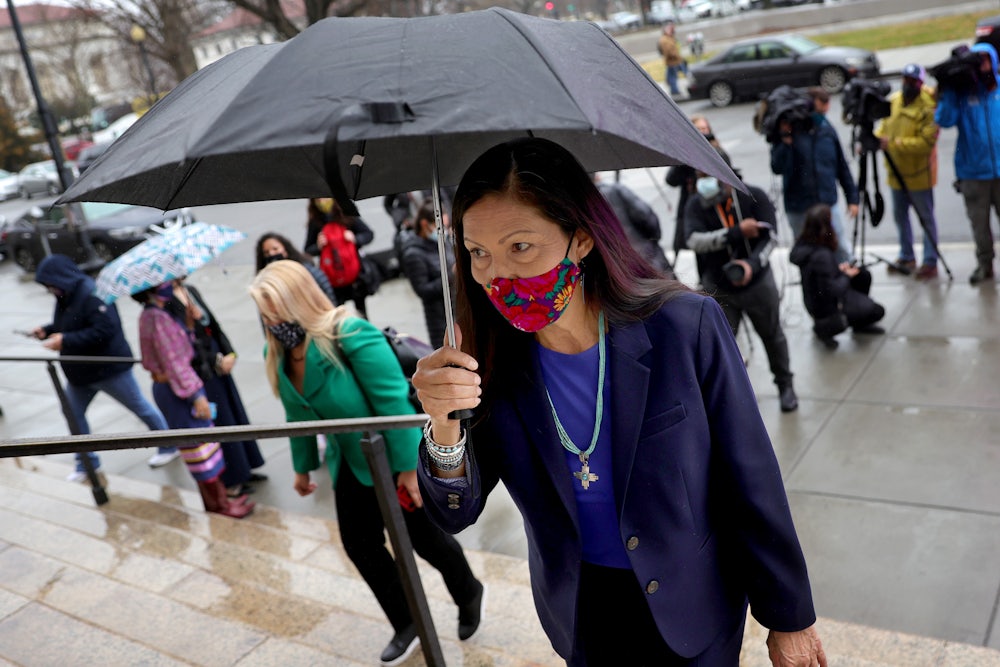On Sunday, The Guardian published a comprehensive report on the environmental, health, and legal issues raised by fracking in the Eastern Agency of the Navajo Nation. In particular, the outlet highlighted instances in which fracking wells owned by Denver-based gas and oil company Enduring Resources had either exploded or malfunctioned, contaminating nearby water sources. In one case from 2019, a fracking well leak brought on by a valve failure pushed 1,400 barrels of slurry off the well pad and into the surrounding snow; by the time the company moved to contain the contaminated area, the snow had melted and the toxins had been washed downstream into the adjacent creek bed. Three days later, an explosion sounded off from another nearby well. Three months later, at another site in the area, 20 barrels of crude oil were sent straight into the earth.
Speaking with The Guardian, Navajo Nation Council officials Mario Atencio and Daniel Tso made the case that all of these spills and the health risks to those living near them (including Atencio’s grandmother) were the result of both well-calculated corporate greed and federal apathy. And looking beyond the Eastern Agency and the Navajo Nation to the whole of Indian Country, it’s hard to disagree with their assessment.
The Guardian’s report comes at a pivotal moment for U.S. fracking policy, as well as Indigenous-federal relations. Since the shale boom of 2009, and for decades before it, the northwest corner of New Mexico, like many other areas in both Indian Country and America, has been transformed into a maze of pipes and well pads. That these operations are densely packed onto the lands of sovereign tribal nations is no accident; it’s part of a much broader trend by extractive outfits, which see rural tribal lands as short-term cash cows and for decades have been mining, fracking, and developing the resources that these communities have stewarded and depended on for millennia. And it’s all been made possible by the governmental entities purportedly tasked with safeguarding the lands for the tribal nations.
Fully understanding why natural gas efforts have focused on this particular New Mexico pocket of Navajo Nation, as opposed to its lands in Arizona—where efforts are more highly concentrated on the lands of the San Carlos Apache and White Mountain Apache tribes—requires a knowledge of trust and fee land statuses and how they’re managed by the individual owners, tribes, and federal government. Many of the lands under review by the Guardian report are known as off-reservation trust lands. This means, legally speaking, that they are not part of the Navajo reservation, where in some cases the process for obtaining a drilling permit is more stringent due to consultation and other regulatory requirements. But the land is still held in trust by the federal Bureau of Indian Affairs for the Diné citizens who live there, and the BIA is tasked with keeping the residents informed regarding decisions about any potential contracting or sales involving the land.
In an area with a high unemployment and poverty rate, when gas and oil companies come knocking with contracts to set up fracking operations on people’s lands, saying no to the upfront cash is a tough sell. More often than not, Atencio pointed out, the oil companies come into the conversations fully lawyered up, while Diné citizens are left alone to make a decision that will affect their homelands for generations to come. As for the BIA, which is in charge of managing land rights for those on trust lands, Tso claimed the agency couldn’t be bothered to lift a finger in opposition to the companies. “Nobody from the BIA advised those folks,” Tso told The Guardian. “The BIA stood in the corner, stood in the shadows. Never said anything.”
We have covered this ground before at The New Republic. This is a familiar story not just about the natural gas industry, though its pipeline sales pitch is particularly ubiquitous across Indian Country. Destructive mining operations like Resolution Copper’s proposed mine on San Carlos Apache lands, much like those overseen by the coal and gas industries, dangle a dwindling number of jobs to communities impoverished by land dispossession and criminally underfunded social programs. They spend a half-century or so poisoning the land and waters, and just when the people have had enough, the companies flee, leaving behind devastating damage—like the underground chambers of phosphorous sludge that FMC Corp buried below the Shoshone-Bannock Tribes.
Any serious attempt to confront the sins of extractive industry also has to consider the federal actors who made this possible. While the Trump administration pushed through an astounding number of gas and oil leases in the final months of its term, the shale boom that drove so many of these companies and corporations to Indian Country happened during the Obama years. As for coal and other resource extraction on Native land, well, that has been a bipartisan effort for as long as America has existed.
So far, the Biden administration has trended toward progress on the matter of ensuring tribal communities are both heard and helped. One of the president’s opening executive actions included a pause on gas and oil leases on public lands, and the Interior Department—which houses both the BIA and the Bureau of Land Management (in charge of leasing public lands for development)—has already hosted a round of consultation sessions with tribal leaders. And what potentially makes this moment in time different from the Obama and Clinton administrations is the fact that the Interior is now led by an official who actually has a record of both combatting further reliance on fossil fuels and supporting Indigenous rights.
Secretary Deb Haaland, who herself hails from New Mexico as a member of the Pueblo of Laguna, is not even a month into her tenure as the head of the Interior, but so far, her department appears to be making good on her stated interest in rolling back drilling operations on public lands. At a virtual conference on the federal oil and gas program held in late March, Haaland said past extractive efforts have been “rushed” without any “careful consideration of the impacts to the environment and future generations of Americans.” She went on to defend the Biden administration’s temporary pause of gas and oil leases on public lands, saying it would allow the Interior to reexamine the federal fossil fuel programs.
Last week, in Haaland’s first television interview, conducted by CBS, she spoke of the way Indian Country has been taken advantage of by extractive interests, saying, “Often, it’s been easy to take land away to drill and mine in sacred places.” The temporary pause will, potentially, allow for her and other Cabinet heads to put in place new, more stringent regulations on how non-Native companies operate on tribal lands. (She has not publicly mentioned any specific changes yet, telling reporters last Friday only that “the American taxpayers deserve to have a return on their investment.”)
One of those solutions that the Biden administration has thus far not moved or signaled a move on is Free, Prior and Informed Consent. Whereas the current model requires only consultation (a box to be checked in most instances), FPIC would require the sign-off of the tribal nation’s government before any new developments proceeded—something that tribal leaders have pressed the Biden administration’s Interior about in its first few months in office. However, while tribes wait for the administration’s position on FPIC, Haaland has already made moves to create a Missing and Murdered Unit within the Bureau of Indian Affairs Office of Justice Services, which will lead and coordinate cross-department and interagency work regarding missing and murdered Indigenous citizens—a crucial endeavor given the crisis coincides often with the transient workforces of extractive companies.
Following the line between wonky Interior policies like FPIC and the on-the-ground effects of fossil fuel extraction can be difficult. But doing so is crucial, because despite what industry stalwarts keep claiming, the consequences of extractive practices from mining to fracking remain a clear danger to communities now and for years to come. As I wrote ahead of Haaland’s confirmation, she will not leave this office having rid Indian Country of all the exploitative industry practices that companies have spent decades codifying into federal law. She even acknowledged this in broad terms when speaking with CBS, admitting that she knows “the fossil fuel industry will continue for years to come.” But Haaland is also on the record having recognized that if America is to properly steward its lands and waters, the federal government cannot continue helping the fossil fuel industry plunder its lands.
Haaland’s Interior now stands at an intersection unlike any faced by previous Interiors. Here we have a Native official in the federal government, from a fracking-heavy state, who throughout her career has made it clear that she has the ability to grasp the economic, cultural, and political forces that define these issues and still produce answers that center tribal sovereignty and the well-being of people and nature alike. There are Capitol and Indian Country politics that may well limit the progress this Interior can achieve. But having someone in charge who gets it—well, that’s a start.








